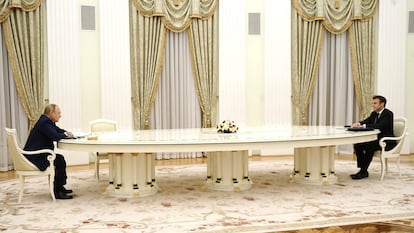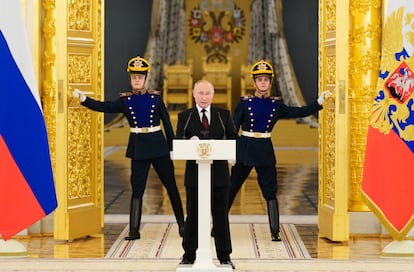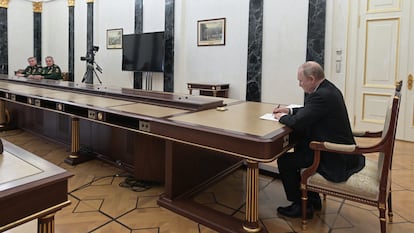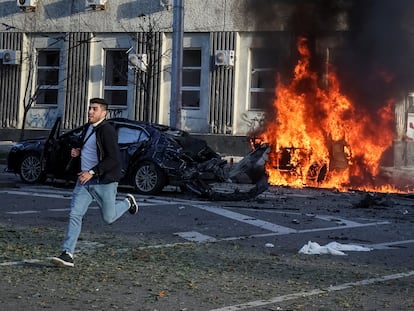The long history of Putin’s giant conference table
Ordered by Kremlin officials who wanted to restore the opulence of tsarist Russia, the Italian-made piece of furniture now symbolizes the chasm between Moscow and the West

The largest country in the world can sit around a wooden table, albeit a very large one. Placed in a Kremlin meeting room, the 20-foot (six meters) conference table became famous when a camera captured Russian President Vladimir Putin and his French counterpart, Emmanuel Macron, sitting at opposite ends during a meeting. The photo gave birth to numerous memes, including one in which the two leaders played badminton across the table, and became a symbol of Russia’s growing estrangement from the West even as the French president made a last-ditch effort to forestall the war in Ukraine.
A Kremlin spokesman said that the seating arrangement had been necessary to protect Putin’s health because Macron refused to get tested for Covid in Moscow. Yet less than two weeks later, Putin sat at a small coffee table with Imran Khan, Pakistan’s prime minister at the time and a Putin ally.
The Kremlin’s most famous table has been linked to Putin since he first became president of Russia, but it was actually made in Italy. When the photo of the Putin-Macron meeting was published, a Spanish cabinetmaker quickly claimed to have made the table, but the world soon learned that it was actually manufactured for the Kremlin in 1995 by Oak, an Italian furniture company. Owner Renato Pologna produced sketches of the table and a certificate signed by Boris Yeltsin, the Russian Federation’s first president, along with documents revealing the table’s dimensions and that the top is made of a single piece of white-lacquered beechwood decorated with gold leaf.

The big, white conference table was not the only piece of Italian-made furniture ordered by the Kremlin. Renato Pologna told the Reuters news agency that shortly after the breakup of the Soviet Union, Russian Federation officials began to research what the Kremlin’s Grand Palace looked like before the 1917 Revolution so that it could be restored to its pre-Stalin glory. Furniture designs were sent to Oak, which billed the Kremlin $20 million for the commissioned reproductions. Pologna says Russian authorities examined all the furniture with giant scanners to check for hidden microphones.
“It’s magnificent!” said Yeltsin in July 1999 when he first viewed the renovated palace, according to an EL PAÍS report. Determined to restore the grandeur of the tsars, the Russian president had spent a fortune on the Kremlin renovations. The Grand Palace had been built for Nicholas I as the imperial family’s residence in Moscow. Important spaces like the St. Catherine Hall were scrupulously restored, but some deplored the dubious aesthetics of other renovations. “It’s not just bad, it’s monstrously bad,” Russian architectural historian Alexei Komech said to The Guardian. “The marble and malachite columns look like something you would see in a restaurant.”
The pharaoh-sized endeavor was also fraught with other problems. In September 1999, the BBC and other international news media reported that Swiss and Russian prosecutors were investigating alleged kickbacks paid to Kremlin officials by Mabetex, the Swiss company in charge of restoring and furnishing the Grand Palace and other Kremlin buildings. According to Italian newspaper Corriere della Sera, Oak was also implicated when investigators suspected that it had laundered money for Russian officials. The scandal touched president Yeltsin himself when it came out that his daughters had used credit cards paid for by Mabetex.

By the time Russian prosecutors closed the case, Yeltsin had exited his palace. On the final New Year’s Eve of the 20th century, the Russian president announced his resignation in a surprise televised address in which he introduced his successor, Vladimir Putin, a virtual unknown until his appointment as prime minister a few months earlier. “The state will stand firm in protecting freedom of speech, freedom of conscience, freedom of the press and private property,” Putin promised in his first speech as president of the Russian Federation, against a backdrop of twinkling Christmas tree lights.
Putin’s enormous conference table and others placed around the Grand Palace are there for intimidation. Putin seats unwelcome visitors like Macron in conference-room Siberia, a tactic he has used with other European leaders like German Chancellor Olaf Scholz. But when Putin met with Brazilian President Jair Bolsonaro, they were seated across the middle of the table instead of at opposite ends.
Whether or not the Kremlin uses conference-table seating to send political messages, it’s never accidental in the movies, where villains and heroes are always at opposite ends. In The Spy Who Loved Me (1977), after trying to throw him into a pool of sharks, evil villain Stromberg places James Bond alone at the opposite end of a huge table under which he hides a gun. Other films have portrayed two diners sitting at opposite ends of a table to represent a lack of communication. In Citizen Kane (1941), Orson Welles depicted the tycoon and his wife’s unhappy marriage by showing them arguing over breakfast at a table that grows progressively longer over the years.
Tu suscripción se está usando en otro dispositivo
¿Quieres añadir otro usuario a tu suscripción?
Si continúas leyendo en este dispositivo, no se podrá leer en el otro.
FlechaTu suscripción se está usando en otro dispositivo y solo puedes acceder a EL PAÍS desde un dispositivo a la vez.
Si quieres compartir tu cuenta, cambia tu suscripción a la modalidad Premium, así podrás añadir otro usuario. Cada uno accederá con su propia cuenta de email, lo que os permitirá personalizar vuestra experiencia en EL PAÍS.
¿Tienes una suscripción de empresa? Accede aquí para contratar más cuentas.
En el caso de no saber quién está usando tu cuenta, te recomendamos cambiar tu contraseña aquí.
Si decides continuar compartiendo tu cuenta, este mensaje se mostrará en tu dispositivo y en el de la otra persona que está usando tu cuenta de forma indefinida, afectando a tu experiencia de lectura. Puedes consultar aquí los términos y condiciones de la suscripción digital.
More information

Fear returns to the streets of Kyiv following Russian strikes
Últimas noticias
Maduro pleads not guilty before the federal court in New York: ‘I am still the president of Venezuela’
A new test can detect Alzheimer’s from a finger prick
UN team enters Sudanese city of El Fasher after paramilitary massacre: ‘It’s like a ghost town’
A recipe for resistance: Indigenous peoples politicize their struggles from the kitchen
Most viewed
- Gilles Lipovetsky: ‘If you want to live better and fall in love, take Prozac, don’t look to philosophy’
- Alain Aspect, Nobel laureate in physics: ‘Einstein was so smart that he would have had to recognize quantum entanglement’
- Alvin Hellerstein, a 92-year-old judge appointed by Bill Clinton, to preside over Maduro’s trial in New York
- Maduro’s downfall puts China’s relationship with Venezuela to the test
- Why oil has been at the center of Venezuela-US conflicts for decades








































